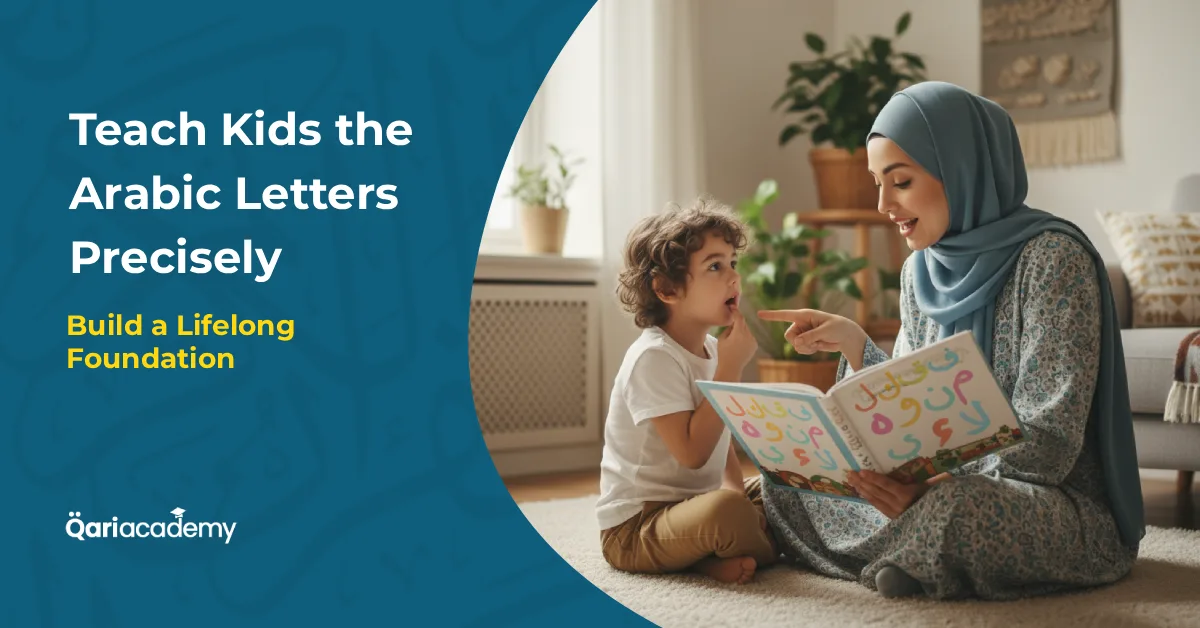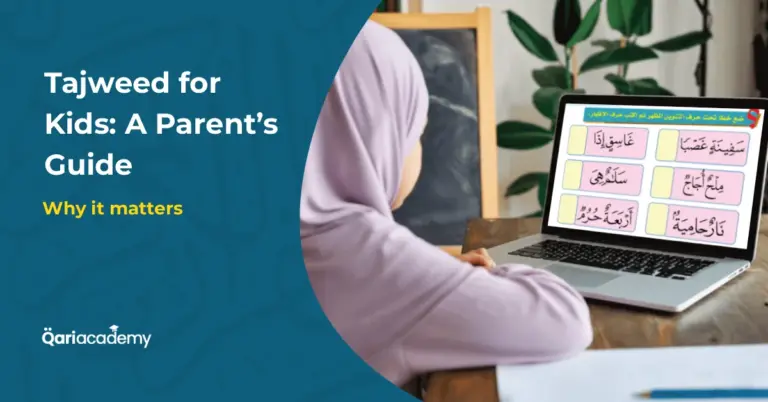
Table of Contents
Introduction
Teaching kids Arabic letters with Tajweed is one of the most important foundations in their Qur’an journey. Many parents ask: “How do I make sure my child learns the Arabic alphabet pronunciation correctly from the beginning?” The answer lies in combining Tajweed precision with fun, age-appropriate methods that keep kids engaged.
If you are still wondering why Tajweed even matters for kids, check out our earlier guide Why Tajweed Matters for Kids: A Parent’s Guide. It will help you see how Tajweed is not just about rules—it’s about protecting the beauty of the Quran in your child’s Quran recitation.
In this article, we’ll explore proven techniques to help your child master Arabic letters step by step, with Tajweed accuracy, in a way that feels natural and enjoyable.
Why Start with Arabic Letters for Kids?
Before children can recite Qur’an with Tajweed, they must recognize and pronounce each Arabic letter correctly. Each letter has a makhraj (articulation point), and even a slight mistake can change the meaning of words in the Qur’an.
For example:
- Mixing up س (seen) with ص (saad) can completely alter meaning.
- Mispronouncing ق (qaf) as ك (kaaf) reduces the depth of the sound.
That’s why building a strong foundation with the Arabic alphabet is essential.
If you are unsure when to start, you can read our article Is Your Child Too Young for Tajweed? where we explain the perfect age to begin and how early exposure benefits children.
Step 1: Introduce Letters Through Sound, Not Just Shape
Most parents begin by showing children the written shape of each Arabic letter. While that’s important, Tajweed learning must start with sound recognition.
- Say the letter slowly and clearly from its makhraj.
- Let your child repeat after you.
- Use mirrors so kids can see how their tongue and lips move.
Tip: Turn it into a game! Say: “Let’s be detectives—where does this sound come from? The throat? The lips? The tongue?”
This approach makes articulation points fun and memorable.
Step 2: Use Stories and Characters for Each Letter
Children love stories. You can give each letter a small “character” or personality.
- Alif: The tall soldier standing straight.
- Baa: The boat floating with one dot.
- Jeem: The letter with a tail who loves to jump.
When kids imagine letters as characters, they retain their shape, sound, and dot placement better.
And remember: consistency is key. Repetition through stories builds confidence without making it feel like “study time.”
Step 3: Practice Tajweed from Day One
Parents often wait until kids finish learning the alphabet before introducing Tajweed. But the truth is, you can teach Tajweed for kids from the very first lesson.
- When teaching taa and ṭaa, exaggerate the difference in depth.
- With haa and ḥaa, help kids “feel” the throat vibration.
- For seen and saad, play a “thin vs. heavy” sound game.
By starting Tajweed early, children grow up associating letters with their proper sounds, instead of forming bad habits that are hard to correct later.
Step 4: Make Practice Multisensory
Children learn best when multiple senses are engaged:
- Visual: Use colorful flashcards and Qur’an-themed charts.
- Auditory: Play recordings of expert Qaris reciting each letter.
- Kinesthetic: Let kids “trace” letters in sand, rice, or air while pronouncing them.
You can even sing the letters in a rhythmic chant—it makes practice stick faster.
Step 5: Correct Gently, Not Strictly
One of the biggest mistakes parents make is correcting children too harshly. If a child feels pressure or fear, they may lose motivation.
Instead:
- Smile and say: “Almost perfect! Let’s try again.”
- Praise effort, not just accuracy.
- Use a “three-time repeat” rule: repeat the correct sound three times together.
Positive reinforcement encourages progress and builds love for Qur’an learning.
Step 6: Use Games for Daily Review
Repetition is the key to mastering Arabic letters, but kids hate boring drills. Instead, use games:
- Memory Match: Match a sound with its written letter card.
- Letter Treasure Hunt: Hide flashcards and let kids “discover” them.
- Wheel of Letters: Spin a wheel and recite the chosen letter with Tajweed.
These playful methods ensure practice happens without resistance.
Step 7: Connect Letters to Real Qur’an Words
As soon as kids know a few letters, connect them to words from the Quran.
For example:
- ب → “Bismillah”
- ق → “Qul”
- ر → “Rahman”
This shows them the real purpose of learning letters: reciting Allah’s words with beauty and respect.
Step 8: Create a Daily 10-Minute Routine
Consistency beats long, irregular sessions. Set a simple routine:
- 2 minutes warm-up (review old letters).
- 5 minutes new practice (one or two new letters).
- 3 minutes fun game or Quran word connection.
Just 10 minutes a day builds mastery faster than a single long weekly session.
Common Mistakes Parents Make
- Starting with writing instead of sounds. Kids must hear and feel letters first.
- Skipping Tajweed until later. This creates habits that are hard to fix.
- Being too strict. Fear blocks learning and love for Quran.
- No routine. Inconsistency slows progress.
Avoiding these mistakes can save months of frustration.
Conclusion: Build a Lifelong Foundation
Teaching kids Arabic letters with Tajweed precision is more than just an educational task—it’s an act of ibadah (worship). By focusing on sounds, using playful methods, and introducing Tajweed from the very beginning, you’re giving your child the tools to connect deeply with the Qur’an for life.
FAQ: Teaching Kids Arabic Letters with Tajweed
Q1: At what age should I start to teach kids Arabic letters with Tajweed?
A: Most children can start recognizing Arabic letters around age 4–5. With Tajweed, it’s best to begin early using playful methods so they naturally develop correct pronunciation.
Q2: Do I need to know Tajweed rules perfectly before teaching my child?
A: Not necessarily. Parents can focus on basic sound accuracy and articulation points. For deeper rules, you can rely on professional teachers or online classes.
Q3: How can I make learning Arabic letters fun for my child?
A: Use games, colorful flashcards, songs, and storytelling. Kids learn faster when practice feels like play.
Q4: My child mixes up similar letters (like س and ص). How do I fix this?
A: Exaggerate the sound differences, use visual cues, and repeat in short, daily sessions. Consistency and gentle correction work best.
Q5: How long does it take to teach kids Arabic letters with Tajweed?
A: With daily 10-minute practice, most kids can recognize and pronounce letters with Tajweed accuracy in 3–6 months.
Q6: Can non-Arabic speaking kids still learn Arabic letters with Tajweed?
A: Absolutely! Children are natural mimics. With repetition and good guidance, even non-Arabic speakers can master correct sounds. We make learning learn Arabic letters fun with our Quran Tajweed Classes online for kids
Q7: What’s the best way to review letters daily?
A: A short routine: review old letters, practice one or two new letters, and end with a fun game or Quran word connection.
Ready to Help Your Child Master Arabic Letters with Tajweed?
At QariAcademy, we make learning Arabic letters with Tajweed simple, fun, and effective.
Our expert teachers use interactive games, visual tools, and proven methods to help your child build a strong Qur’an foundation—step by step.
👉 Don’t wait. Give your child the gift of correct Quran recitation today!
Enroll in QariAcademy’s Kids Tajweed Course Now





